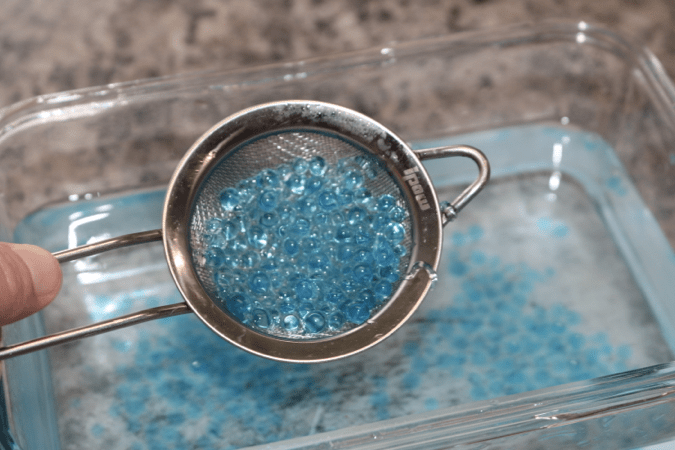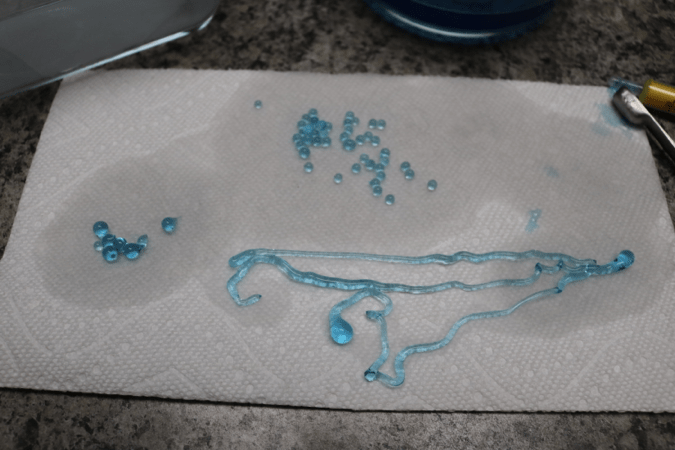Believe it or not, we use a lot of chemistry to make the food we love to eat. For example, polysaccharides are naturally occurring polymers found in algae, bacteria, citrus fruits, and other plants and animals. Polysaccharides are used in foods to help change or control the consistency. They are used to emulsify, or thicken liquids or create gels. Here are some examples of foods you might find in your fridge and pantry that contain polysaccharides as thickening or gelling agents.
To see if a food contains polysaccharides, read the nutrition label and look for any of the following ingredients:
- Xanthan gum
- Alginate
- Agar (or agar-agar)
- Guar gum
- Pectin
- Tapioca starch
- Carrageenan
- Modified food starch
Chefs use the polysaccharide sodium alginate (extracted from brown algae) in molecular gastronomy in a technique that chefs call spherification, while scientists call it cross-linking. Cross-linking is the bonding of two or more polymer strands together through physical or chemical bonds.
Chefs use spherification to make popping boba, cross-linked spheres with a thin, gel-like skin with juice inside that bursts when squeezed. Popping boba are made by adding sodium alginate to a flavored liquid, then dropping that liquid mixture into a bath of calcium chloride. The calcium replaces the sodium ions which “links” the polymer chains together, forming a network that keeps the liquid contained.
A drawing of sodium ions and alginate polymer chains in solution on the left side, then an arrow labeled calcium chloride solution in the middle, indicating when the sodium alginate solution is dropped into the calcium chloride solution. On the right side, the drawing shows that calcium ions have replaced the sodium ions, linking the polymer chains together.
Popping Boba balls are a GREAT example of ionic cross-linking polymers that you can eat. So, let’s get started!
Popping Boba
Materials
- 1 tsp sodium alginate
- 1 tsp calcium chloride
- 5 c distilled water (This is important. The water cannot contain any calcium or magnesium or else the mixture will cross-link prematurely)
- Syringes or droppers (clean medicine droppers work great)
- Thermometer
- Fine mesh strainer
- Heat safe container for the alginate solution
- 2 containers for the calcium chloride solution and fresh distilled water
Note: Sodium alginate and calcium chloride are available from Amazon, MolecularRecipes.com, and willpower.net
Optional Materials
- Food coloring
- Flavorings (honey, chocolate syrup, grape juice, and pear nectar work great, make sure they do not contain calcium or magnesium by reading the nutritional label)
- Tonic water (use instead of distilled water if you want your Boba to glow under ultraviolet or black light)
Steps
- Whisk together 1 c distilled water, sodium alginate, and food coloring if using, in a pot and heat over medium-high heat. If you are using flavorings, add those too—make sure to keep the total amount of liquid to 2 c.
- Stir the solution until the sodium alginate dissolves and the solution reaches 180–190 °F.
![A picture of a saucepan with sodium alginate and distilled water solution bubbling, with a thermometer indicating the temperature at 190˚F.]](https://sites.udel.edu/k12engineering/files/2020/09/thermometeralginate.png)
- A picture of a saucepan with sodium alginate and distilled water solution bubbling, with a thermometer indicating the temperature at 190˚F.
- Remove the solution from the heat, transfer to heat resistant bowl and let cool for a couple of hours or overnight in the fridge to allow the bubbles to pop. This is your alginate solution.
- Stir the calcium chloride into 2 c distilled water in a wide mouth container. This solution is the solution you will drop the alginate solution in to form the Boba.
- Set aside the remaining 2 c of distilled water in a separate wide mouth container. You will later use this to help wash off the salt bath, so your Boba do not taste salty.

A picture of materials set up to make boba: a glass bowl containing a cloudy white solution of calcium chloride, a second bowl containing a blue sodium alginate solution, a small wire strainer, and two syringe-style medicine droppers.
- To make the Boba balls, fill the dropper with the alginate solution and slowly drop it into the calcium chloride solution.
- Stir the balls around, so they don’t get stuck together and keep them in the calcium chloride solution for about 30 seconds.

A picture of a hand using a syringe-style medicine dropper filled with blue sodium alginate solution over a glass bowl containing a cloudy white solution of calcium chloride.
- Using the mesh strainer, transfer the balls to the glass bowl with the fresh distilled water to wash off the salt and stir.

A photograph of a hand holding a wire mesh strainer filled with blue boba balls. The boba balls formed in the cloudy white solution of calcium chloride after sodium alginate solution was dropped into it. There are a few blue boba balls still left behind in the calcium chloride solution that were not scooped up by the strainer.
- Move the Boba from the water using the mesh strainer to a paper towel to dry them off.

A photograph of a wire mesh strainer resting on a paper towel, with blue boba balls spilled out of it onto the towel. Behind the towel and strainers, the containers of calcium chloride solution and sodium alginate solution are visible.
Now you can eat them or pop them in your hand. Enjoy playing around with the Boba!
Questions to help you explore
- How could you make different shape Boba (like worms), or bigger or smaller Boba? Experiment and see what happens!

A photograph of a paper towel, with blue boba balls of various sizes and shapes on it, including sphere, teardrop, and long squiggly worm shapes.
- Do the larger Boba take longer to solidify compared to the small Boba?
- What happens if your leave the Boba in the calcium chloride solution for a few minutes? Does the amount of liquid in the center of the Boba change?
- What happens if you change the height you drop the alginate solution above the calcium chloride bath?
- Can you make two-colored Boba without having the colors mix?

A close-up photograph of a paper towel, with boba globs of various sizes and shapes on it. The boba are both green and blue, in the same globule.
More Information
Check out these sources for more information on polymers, cross-linking, and spherification.
The Science Behind Spherification
The Diverse World of Polymers
Crash Course in Polymers
©2020 UD K-12 Engineering
